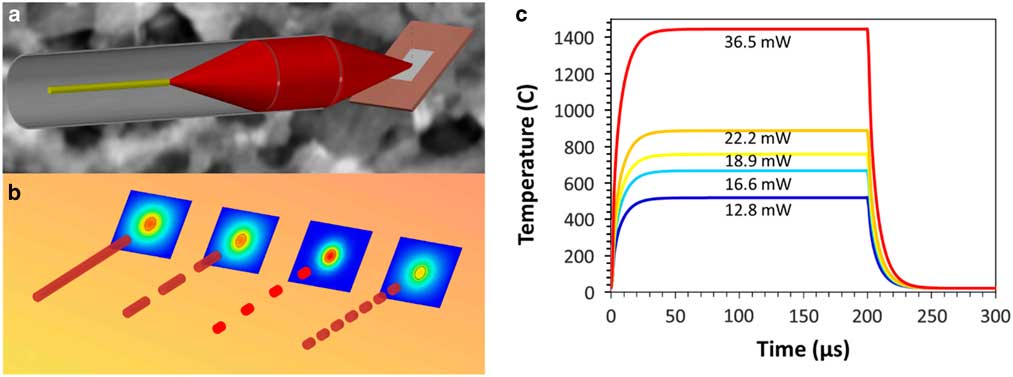Exploring Photothermal Pathways via in situ Laser Heating in the TEM
Collaborators from University of Notre Dame, University of Tennessee, and Oak Ridge National Lab explored photothermal heating pathways using the Waviks Vesta. Their work was published in Microscopy and Microanalysis.

Figure 1 a: Schematic illustrating the end of the optical delivery system which re-images a laser-coupled single mode fiber optical fiber onto the transmission electron microscopy sample. b: Schematic illustrating that various laser conditions can generate numerous in situ photothermal pathways via different combinations of laser power (up to 215 mW), pulse width (1 ns to CW), number of pulses and radial position. c: Time–temperature plots from a finite element photothermal simulation of 20-nm thick Ag0.5Ni0.5 film on a 20 nm SiO2 membrane exposed to various laser powers explored in this study.
Rapid materials synthesis and characterization of materials systems is critical to advances in a wide variety of applications from electronic devices to more fuel efficient automobiles. To accomplish this, one critical pathway is the development of combinatorial approaches to rapidly synthesize multicomponent material libraries. Another critical need is the development of in situ and rapid ex situ characterization approaches, so that materials can be exposed to external stimuli and the subsequent responses can be measured to elucidate, for instance, the free-energy landscape of various phase transformations. Among the various characterization techniques (scanning) transmission electron microscopy [(S)TEM], and its associated spectroscopic complements, is one of the few techniques in which this information can be gathered with atomic scale resolution. Thus, there has been a concerted effort to develop various in situ accoutrements for the (S)TEM, examples include: in situ heating stages, gas and liquid cells, optical delivery and collection. Furthermore, over the past few decades, a few groups across the world have developed very complex and specialized ultrafast electron microscope or dynamic TEM systems using photo-cathodes that are exposed to short laser pulses to generate electron beamlets (and single electrons), that synchronously arrive at the sample in time relative to another pulsed laser directed at the same sample. Motivated by the above and the desire to develop a commercially available and more ubiquitous system useful for a variety of optical in situ studies, Waviks Inc. has developed a new photon delivery system which can be mounted on any (S)TEM system.
Reference:
Wu, Y., Liu, C., Moore, T., Magel, G., Garfinkel, D., Camden, J., . . . Rack, P. (2018). Exploring Photothermal Pathways via in Situ Laser Heating in the Transmission Electron Microscope: Recrystallization, Grain Growth, Phase Separation, and Dewetting in Ag0.5Ni0.5 Thin Films. Microscopy and Microanalysis, 24(6), 647-656.
doi:10.1017/S1431927618015465
